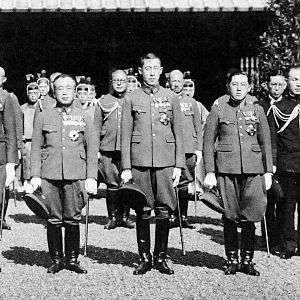Korea under Japanese rule
Japanese Korea (Japanese: 大日本帝国 (朝鮮), Dai-Nippon Teikoku [Chōsen]) was the period when Korea was under Japanese rule, between 1910 and 1945.
Japanese Korea | |||||||||||||
|---|---|---|---|---|---|---|---|---|---|---|---|---|---|
| 1910–1945 | |||||||||||||
 Seal of the Government-General of Korea | |||||||||||||
Anthem:
| |||||||||||||
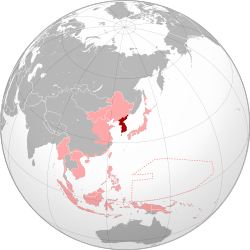 Korea (dark red) within the Empire of Japan (light red) at its furthest extent | |||||||||||||
| Status | Colony of the Empire of Japan | ||||||||||||
| Capital | |||||||||||||
| Common languages | Japanese (official) Korean | ||||||||||||
| Religion |
| ||||||||||||
| Government | Monarchy | ||||||||||||
| Emperor | |||||||||||||
• 1910–1912 | Meiji | ||||||||||||
• 1912–1926 | Taishō | ||||||||||||
• 1926–1945 | Shōwa | ||||||||||||
• 1910–1916 (first) | Terauchi Masatake | ||||||||||||
• 1944–1945 (last) | Nobuyuki Abe | ||||||||||||
| Historical era | Empire of Japan | ||||||||||||
| 17 November 1905 | |||||||||||||
• Annexation treaty signed | 22 August 1910 | ||||||||||||
• Annexation by Japan | 29 August 1910 | ||||||||||||
| 1 March 1919 | |||||||||||||
• Sōshi-kaimei order | 10 November 1939 | ||||||||||||
| 15 August 1945 | |||||||||||||
| Currency | Korean yen | ||||||||||||
| |||||||||||||
| Today part of | |||||||||||||
Part of a series on the |
||||||||
|---|---|---|---|---|---|---|---|---|
| History of Korea | ||||||||
 | ||||||||
| Prehistoric period | ||||||||
| Ancient period | ||||||||
|
||||||||
| Proto–Three Kingdoms period | ||||||||
| Three Kingdoms period | ||||||||
|
||||||||
| Northern and Southern States period | ||||||||
|
||||||||
| Later Three Kingdoms period | ||||||||
|
||||||||
| Dynastic period | ||||||||
|
||||||||
| Colonial period | ||||||||
|
||||||||
| Modern period | ||||||||
|
||||||||
| Topics | ||||||||
| Timeline | ||||||||
Joseon Korea came under the Japanese sphere of influence in the Japan–Korea Treaty of 1876 and a complex coalition of the Meiji government, military, and business officials began a process of Korea's political and economic integration into Japan. The Korean Empire became a protectorate of Japan in 1905 in the Japan–Korea Treaty of 1905 and the country was indirectly ruled by the Japanese through the Resident-General of Korea. Japan formally annexed the Korean Empire in 1910 in the Japan–Korea Treaty of 1910, without the consent of Gojong, the regent of the Korean Emperor Sunjong.[6][7][8] The Japanese Empire had established the Korean Peninsula as a colony of Japan administered by the General Government based in Keijō (Gyeongseong) which governed Korea with near-absolute power.
Japanese rule prioritized Korea's Japanization, accelerating industrialization started by the Gwangmu Reform, building public works, and fighting the Korean independence movement.[9][10][11]
Japanese rule over Korea ended on 15 August 1945 upon the Surrender of Japan in World War II, and the armed forces of the United States and the Soviet Union occupied the territory. The Division of Korea separated the Korean Peninsula under two governments and economic systems with the northern Soviet Civil Administration and the southern United States Army Military Government in Korea. In 1965, the Treaty on Basic Relations between Japan and South Korea declared the unequal treaties between Japan and Korea, especially 1905 and 1910, were "already null and void" at the time of their promulgation.[8][12] Japanese rule remains controversial in modern-day North Korea and South Korea and its negative repercussions continue to affect these countries, including the industrialization plan to solely benefit Japan, the exploitation of Korean people, the marginalization of Korean history and culture, the environmental exploitation of the Korean Peninsula, and the status of Japanese collaborators known as Chinilpa.[13]
Terminology
In South Korea, the period is usually described as the "Japanese forced occupation" (Korean: 일제 강점기; Hanja: 日帝强占期; RR: Ilje Gangjeom-gi). Other terms, although often considered obsolete, include "Japanese Imperial Period" (Korean: 일제시대; Hanja: 日帝時代; RR: Ilje Sidae), "The dark Japanese Imperial Period" (Korean: 일제암흑기; Hanja: 日帝暗黑期; RR: Ilje Amheuk-gi), "period of the Japanese imperial colonial administration" (Korean: 일제 식민 통치 시대; Hanja: 日帝植民統治時代; RR: Ilje Sikmin Tongchi Sidae), and "Wae (Japanese) administration" (Korean: 왜정; Hanja: 倭政; RR: Wae-jeong).
In Japan, the term "Chōsen (Korea) of the Japanese-Governed Period" (日本統治時代の朝鮮, Nippon Tōchi-jidai no Chōsen) has been used.
Background
Political turmoil in Korea
Japan–Korea Treaty of 1876
.jpg)
On 27 February 1876, the Japan–Korea Treaty of 1876, also known in Japan as the Japanese–Korea Treaty of Amity (日朝修好条規, Nitchō-shūkōjōki, Korean: 강화도조약; Hanja: 江華島條約; RR: Ganghwado joyak) was signed. It was designed to open up Korea to Japanese trade, and the rights granted to Japan under the treaty were similar to those granted Western powers in Japan following the visit of Commodore Perry in 1854.[14] However, the treaty ended Korea's status as a protectorate of China, forced open three Korean ports to Japanese trade, granted extraterritorial rights to Japanese citizens, and was an unequal treaty signed under duress (gunboat diplomacy) of the Ganghwa Island incident of 1875.[14]
As a result of the treaty, Japanese merchants came to Busan, which became the center for foreign trade and commerce. Japanese officials then published Korea's first newspaper, Chōsen shinpō (朝鮮新報), in 1881. Chinese language articles were aimed at Korea's educated elite, which advocated for constitutional government, freedom of speech, strong rule of law and legal rights, and Korean-led industrialization. Few of these goals came to pass. Japanese language articles focused on news regarding business, specifically "the stagnant Pusan trade" in rice and other farmed goods, which fluctuated wildly due to weather conditions and the whims of the tax-levying elite class. It ceased publication sometime after May 1882.[15]
Imo Incident
The Daewongun, who remained opposed to any concessions to Japan or the West, helped organize the Mutiny of 1882, an anti-Japanese outbreak against Queen Min and her allies.[16] Motivated by resentment of the preferential treatment given to newly trained troops, the Daewongun's forces, or "old military", killed a Japanese training cadre, and attacked the Japanese legation.[16] Japanese diplomats,[17] policemen,[18] students[19] and some Min clan members were also killed during the incident. The Daewongun was briefly restored to power, only to be forcibly taken to China by Chinese troops dispatched to Seoul to prevent further disorder.[16]
In August 1882, the Treaty of Jemulpo (Japan–Korea Treaty of 1882) indemnified the families of the Japanese victims, paid reparations to the Japanese government in the amount of 500,000 yen, and allowed a company of Japanese guards to be stationed at the Japanese legation in Seoul.[16]
Gapsin coup
The struggle between the Heungseon Daewongun's followers and those of Queen Min was further complicated by competition from a Korean independence faction known as the Progressive Party (Gaehwa-dang), as well as the Conservative faction. While the former sought Japan's support, the latter sought China's support.[16] On 4 December 1884, the Progressive Party, assisted by the Japanese, attempted a coup (Gapsin coup) and established a pro-Japanese government under the reigning king, dedicated to the independence of Korea from Chinese suzerainty.[16] However, this proved short-lived, as conservative Korean officials requested the help of Chinese forces stationed in Korea.[16] The coup was put down by Chinese troops, and a Korean mob killed both Japanese officers and Japanese residents in retaliation.[16] Some leaders of the Progressive Party, including Kim Ok-gyun, fled to Japan, while others were executed.[16] For the next 10 years, Japanese expansion into the Korean economy was approximated only by the efforts of czarist Russia.
Donghak Revolution and First Sino-Japanese War

The outbreak of the Donghak peasant revolution in 1894 provided a seminal pretext for direct military intervention by Japan in the affairs of Korea. In April 1894, the Korean government asked for Chinese assistance in ending the Donghak peasant revolt. In response, Japanese leaders, citing a violation of the Convention of Tientsin as a pretext, decided upon military intervention to challenge China. On 3 May 1894, 1,500 Qing forces appeared in Incheon. The same day, 6,000 Japanese forces also landed in Incheon, producing the Sino-Japanese War. Japan won the First Sino-Japanese War, and China signed the Treaty of Shimonoseki in 1895. Among its many stipulations, the treaty recognized "the full and complete independence and autonomy of Korea", thus ending Korea's tributary relationship with the Chinese Qing dynasty, leading to the proclamation of full independence of Joseon Korea in 1895. At the same time, Japan suppressed the Donghak revolution with Korean government forces. With the exception of czarist Russia, Japan now held military predominance in Korea.
Assassination of Queen Min
The Japanese minister to Korea, Miura Gorō, orchestrated a plot against 43-year-old Queen Min (later given the title of "Empress Myeongseong"), and on 8 October 1895, she was assassinated by Japanese agents.[20] In 2001, Russian reports on the assassination were found in the archives of the Foreign Ministry of the Russian Federation. The documents included the testimony of King Gojong, several witnesses of the assassination, and Karl Ivanovich Weber's report to Aleksey Lobanov-Rostovsky, the Foreign Minister of Russia, by Park Jonghyo. Weber was the chargé d'affaires at the Russian legation in Seoul at that time.[20] According to a Russian eyewitness, Seredin-Sabatin, an employee of the king, a group of Japanese agents entered Gyeongbokgung,[21] killed Queen Min, and desecrated her body in the north wing of the palace.
When he heard the news, Heungseon Daewongun returned to the royal palace the same day.[20] On 11 February 1896, King Gojong and the crown prince moved from Gyeongbokgung to the Russian legation in Jeong-dong, Seoul, from where they governed for about one year, an event known as the Korea royal refuge at the Russian legation.
Democracy protests and the proclamation of the Korean Empire
After the Royal Refuge, some Korean activists established the Independence Club (독립협회; 獨立協會) in 1896. They claimed that Korea should negotiate with Western powers, particularly Russia, to counterbalance the growing influence of Japan. In 1897, this club had destroyed the 1537 Yeongeunmun, a special gate where Chinese envoys had been escorted and received, and contributed to the construction of Independence Gate and they held regular meetings in the Jongno streets, demanding democratic reforms as Korea became a constitutional monarchy, and an end to Japanese and Russian influence in Korean affairs.
In October 1897, Gojong decided to return to his other palace, Deoksugung, and proclaimed the founding of the Korean Empire. During this period, the Korean government conducted a westernization policy. It was not an enduring reform, however, and the Independence Club was dissolved on 25 December 1898 as the new Emperor Gojong officially announced a prohibition on unofficial congresses.
Prelude to annexation
.svg.png)
Having established economic and military dominance in Korea in October 1904, Japan reported that it had developed 25 reforms which it intended to introduce into Korea by gradual degrees. Among these was the intended acceptance by the Korean Financial Department of a Japanese Superintendent, the replacement of Korean Foreign Ministers and consuls by Japanese and the "union of military arms" in which the military of Korea would be modeled after the Japanese military.[22] These reforms were forestalled by the prosecution of the Russo-Japanese War from 8 February 1904, to 5 September 1905, which Japan won, thus eliminating Japan's last rival to influence in Korea.[23] Under the Treaty of Portsmouth, signed in September 1905, Russia acknowledged Japan's "paramount political, military, and economic interest" in Korea.[23]
Two months later, Korea was obliged to become a Japanese protectorate by the Japan–Korea Treaty of 1905 and the "reforms" were enacted, including the reduction of the Korean Army from 20,000 to 1,000 men by disbanding all garrisons in the provinces, retaining only a single garrison in the precincts of Seoul.[23] On 6 January 1905, Horace Allen, head of the American Legation in Seoul reported to his Secretary of State, John Hay, that the Korean government had been advised by the Japanese government "that hereafter the police matters of Seoul will be controlled by the Japanese gendarmerie" and "that a Japanese police inspector will be placed in each prefecture".[24] A large number of Koreans organized themselves in education and reform movements, but Japanese dominance in Korea had become a reality.[23]
In June 1907, the Second Peace Conference was held in The Hague. Emperor Gojong secretly sent three representatives to bring the problems of Korea to the world's attention. The three envoys were refused access to the public debates by the international delegates who questioned the legality of the protectorate convention. Out of despair, one of the Korean representatives, Yi Tjoune, committed suicide at The Hague.[25] In response, the Japanese government took stronger measures. On 19 July 1907, Emperor Gojong was forced to relinquish his imperial authority and appoint the Crown Prince as regent. Japanese officials used this concession to force the accession of the new Emperor Sunjong following abdication, which was never agreed to by Gojong. Neither Gojong nor Sunjong was present at the 'accession' ceremony. Sunjong was to be the last ruler of the Joseon dynasty, founded in 1392.[26]
Japan–Korea annexation treaty (1910)

In May 1910, the Minister of War of Japan, Terauchi Masatake, was given a mission to finalize Japanese control over Korea after the previous treaties (the Japan–Korea Treaty of 1904 and the Japan–Korea Treaty of 1907) had made Korea a protectorate of Japan and had established Japanese hegemony over Korean domestic politics. On 22 August 1910, Japan effectively annexed Korea with the Japan–Korea Treaty of 1910 signed by Ye Wanyong, Prime Minister of Korea, and Terauchi Masatake, who became the first Japanese Governor-General of Korea.
The treaty became effective the same day and was published one week later. The treaty stipulated:
- Article 1: His Majesty the Emperor of Korea concedes completely and definitely his entire sovereignty over the whole Korean territory to His Majesty the Emperor of Japan.
- Article 2: His Majesty the Emperor of Japan accepts the concession stated in the previous article and consents to the annexation of Korea to the Empire of Japan.
Both the protectorate and the annexation treaties were declared already void in the 1965 Treaty on Basic Relations between Japan and the Republic of Korea .
This period is also known as Military Police Reign Era (1910–19) in which Police had the authority to rule the entire country. Japan was in control of the media, law as well as government by physical power and regulations.
In March 2010, 109 Korean intellectuals and 105 Japanese intellectuals met in the 100th anniversary of Japan–Korea Treaty of 1910 and they declared this annexation treaty null and void. They declared these statements in each of their capital cities (Seoul and Tokyo) with a simultaneous press conference. They announced the "Japanese empire pressured the outcry of the Korean Empire and people and forced by Japan–Korea Treaty of 1910 and full text of a treaty was false and text of the agreement was also false". They also declared the "Process and formality of "Japan–Korea Treaty of 1910" had huge deficiencies and therefore the treaty was null and void. This meant the March 1st Movement was not an illegal movement.[27][28][29]
Pre-World War II (1910–41)
Japanese migration and land ownership
From around the time of the First Sino-Japanese War of 1894–1895, Japanese merchants started settling in towns and cities in Korea seeking economic opportunity. By 1910 the number of Japanese settlers in Korea had reached over 170,000, comprising the largest single overseas-Japanese community in the world at the time. The Japanese leadership, convinced that their own country was overcrowded – especially in rural areas – encouraged farmers to emigrate.
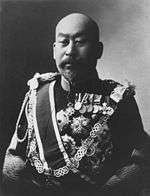
Many Japanese settlers showed interest in acquiring agricultural land in Korea even before Japanese land-ownership was officially legalized in 1906. Governor-General Terauchi Masatake facilitated settlement through land reform, which initially proved popular with most of the Korean population. The Korean land-ownership system featured absentee landlords, only partial owner-tenants and cultivators with traditional (but no legal proof of) ownership. Terauchi's new Land Survey Bureau conducted cadastral surveys that established ownership on the basis of written proof (deeds, titles, and similar documents). The system denied ownership to those who could not provide such written documentation; these turned out to be mostly high-class and impartial owners who had only traditional verbal cultivator-rights. Japanese landlords included both individuals and corporations (such as the Oriental Development Company). Because of these developments, Japanese landownership soared, as did the amount of land taken over by private Japanese companies.[30] Many former Korean landowners, as well as agricultural workers, became tenant farmers, having lost their entitlements almost overnight because they could not pay for the land reclamation and irrigation improvements forced on them.[31] Compounding the economic stresses imposed on the Korean peasantry, the authorities forced Korean peasants to do long days of compulsory labor to build irrigation works; Japanese imperial officials made peasants pay for these projects in the form of heavy taxes, impoverishing many of them and causing even more of them lose their land.[32] Although many other subsequent developments placed ever greater strain on Korea's peasants, Japan's rice shortage in 1918 was the greatest catalyst for hardship. During that shortage, Japan looked to Korea for increased rice cultivation; as Korean peasants started producing more for Japan, however, the amount they took to eat dropped precipitously, causing much resentment among them.[33]
By 1910 an estimated 7 to 8% of all arable land in Korea had come under Japanese control. This ratio increased steadily; as of the years 1916, 1920, and 1932, the ratio of Japanese land ownership increased from 36.8 to 39.8 to 52.7%. The level of tenancy was similar to that of farmers in Japan itself; however, in Korea, the landowners were mostly Japanese, while the tenants were all Koreans. As often occurred in Japan itself, tenants had to pay over half their crop as rent, forcing many to send wives and daughters into factories or prostitution so they could pay taxes.[34]
By the 1930s the growth of the urban economy and the exodus of farmers to the cities had gradually weakened the hold of the landlords. With the growth of the wartime economy, the government recognized landlordism as an impediment to increased agricultural productivity, and took steps to increase control over the rural sector through the formation in Japan in 1943 of the Central Agricultural Association (中央農会, Chūō nōkai), a compulsory organization under the wartime command economy.
Anthropology and cultural heritage
In 1925, the Japanese government established the Korean History Compilation Committee, and it was administered by the Governor-General of Korea and engaged in collecting Korean historical materials and compiling Korean history.[35] According to the Doosan Encyclopedia, some mythology was incorporated.[36] The committee said that Korea had once hosted a Japanese colony called Mimana,[36] which has since been debated by academic scholarship.[37]
The Japanese government conducted excavations of archeological sites and preserved artifacts found there.[38] The Japanese administration also relocated some artifacts; for instance, a stone monument (hanja: 棕蟬縣神祠碑), which was originally located in the Liaodong Peninsula, was taken out of its context and moved to Pyongyang.[39]
The National Palace Museum of Korea, originally built as the "Korean Imperial Museum" in 1908 to preserve the treasures in the Gyeongbokgung, was retained under the Japanese administration but renamed "Museum of the Yi Dynasty" in 1938.[40]
The Governor-General of Korea instituted a law in 1933 in order to preserve Korea's most important historical artifacts. The system established by this law, retained as the present-day National Treasures of South Korea and National Treasures of North Korea, was intended to counter the deleterious effects of the speed of economic development as well as the lack of concern by Japanese developers for Korean cultural heritage on Korean historical artifacts, including those not yet unearthed.[41]
Gyeongbokgung, the Korean royal palace, was demolished during the Japanese occupation. In 1911, shortly after the annexation of Korea by Japan, ownership of land at the palace was transferred to the Japanese Governor-General of Korea. In 1915, to hold an exhibition, more than 90% of the buildings were torn down. Following the exhibition, the Japanese leveled whatever still remained and built their administrative headquarters, the Government-General Building (1916–26), on the site.
Restoration of Gyeongbokgung has been undertaken since 1990. The Government-General Building was removed in 1996 and Heungnyemun (2001) and Gwanghwamun (2006–10) were reconstructed in their original locations and forms. Reconstructions of the Inner Court and Crown Prince's residence have also been completed.
Anti-Chinese riots of 1931
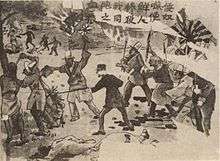
In 1931, Korean immigrants in Manchuria led to a series of anti-Chinese riots erupted throughout Korea in 1931. Due to a waterway construction permit, in the small town of Wanpaoshan near Changchun, "violent clashes" broke out between the Chinese and Korean in 2 July. The Chosun Ilbo, a major Korean newspaper, misreported that many Koreans had died in the clashes, sparking a Chinese exclusion movement in urban areas of the Korean Peninsula.[42]The worst of the rioting occurred in Pyongyang on 5 July. Approximately 127 Chinese people were killed, 393 wounded, and a considerable number of properties were destroyed by Korean residents.[43] Republic of China further alleged the Japanese authorities in Korea did not take adequate steps to protect the lives and property of the Chinese residents, and blamed the authorities for allowing inflammatory accounts to be published. As a result of this riot, the Minister of Foreign Affairs Kijūrō Shidehara, who insisted on Japanese, Chinese, and Korean harmony, lost his position.[43]
Order to change names
Attempts were made to introduce the modern household registration system. This brought about the abolishment of the Korean caste system. In 1911, the proclamation "Matter Concerning the Changing of Korean Names" (朝鮮人ノ姓名改称ニ関スル件) was issued, barring ethnic Koreans from taking Japanese names and retroactively reverting the names of Koreans who had already registered under Japanese names back to the original Korean ones.[44][44] By 1939, however, this position was reversed and Japan's focus had shifted towards cultural assimilation of the Korean people; Imperial Decree 19 and 20 on Korean Civil Affairs (Sōshi-kaimei) went into effect, whereby ethnic Koreans were forced to surrender their traditional use of clan-based Korean family name system, in favor for a new surname to be used in the family register. The surname could be of their own choosing, including their native clan name, but in practice many Korean received a Japanese surname. There is controversy over whether or not the adoption of a Japanese surname was effectively mandatory, or merely strongly encouraged.[45][46]
World War II
National Mobilization Law
Deportation of forced labor
Korean migration had increased after World War I and accelerated after 1930; in 1939, there were 981,000 Koreans living in the Japanese archipelago as internal migrants.
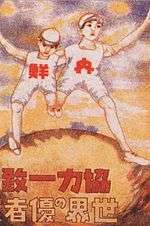
The combination of immigrants and forced laborers during World War II brought the total to over 2 million by the end of the war, according to estimates by the Supreme Commander for the Allied Powers. In 1946, some 1,340,000 ethnic Koreans were repatriated to Korea, with 650,000 choosing to remain in Japan,[48] where they now form the Zainichi Korean community. A 1982 survey by the Korean Youth Association showed that conscripted laborers account for 13 percent of first-generation Zainichi Koreans.
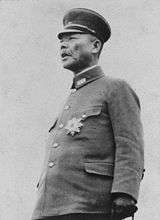
From 1939, labor shortages as a result of conscription of Japanese males for the military efforts of World War II led to organized official recruitment of Koreans to work in mainland Japan, initially through civilian agents, and later directly, often involving elements of coercion. As the labor shortage increased, by 1942, the Japanese authorities extended the provisions of the National Mobilization Law to include the conscription of Korean workers for factories and mines on the Korean Peninsula, Manchukuo, and the involuntary relocation of workers to Japan itself as needed.
Of the 5,400,000 Koreans conscripted, about 670,000 were taken to mainland Japan (including Karafuto Prefecture, present-day Sakhalin, now part of Russia) for civilian labor. Those who were brought to Japan were often forced to work under appalling and dangerous conditions.[49] Apparently Koreans were better treated than laborers from other countries, but still their work hours, food and medical care were such that large numbers died. This is clear from the 60,000 Korean laborers that died in Japan out of the near 670,000 that were brought there in the years 1939 to 1945 (line 119a).[50] The total number of deaths of Korean forced laborers in Korea and Manchuria is estimated to be between 270,000 and 810,000.[50] The 43,000 ethnic Koreans in Karafuto, which had been occupied by the Soviet Union just prior to Japan's surrender, were refused repatriation to either mainland Japan or the Korean Peninsula, and were thus trapped in Sakhalin, stateless; they became the ancestors of the Sakhalin Koreans.[51]
Most Korean atomic-bomb victims in Japan had been drafted for work at military industrial factories in Hiroshima and Nagasaki.[52] In the name of humanitarian assistance, Japan paid South Korea four billion yen (approx. thirty five million dollars) and built a welfare center for those suffering from the effects of the atomic bomb.[53]
Korean service in the Japanese military
| Year | Applicants | Applicants accepted | Acceptance rate [%] |
|---|---|---|---|
| 1938 | 2,946 | 406 | 13.8 |
| 1939 | 12,348 | 613 | 5.0 |
| 1940 | 84,443 | 3,060 | 3.6 |
| 1941 | 144,743 | 3,208 | 2.2 |
| 1942 | 254,273 | 4,077 | 1.6 |
| 1943 | 303,294 | 6,300[56] | 2.1 |
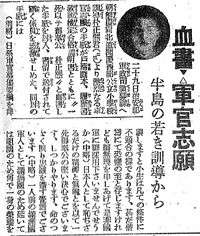
Japan did not draft ethnic Koreans into its military until 1944 when the tide of World War II turned against it. Until 1944, enlistment in the Imperial Japanese Army by ethnic Koreans was voluntary, and highly competitive. From a 14% acceptance rate in 1938, it dropped to a 2% acceptance rate in 1943 while the raw number of applicants increased from 3000 per annum to 300,000 in just five years during World War II.
Korea produced seven generals and numerous field grade officers (Colonels, Lieutenant-Colonels and Majors) during 35 years of colonial governance by Japan, despite institutionalized discrimination. The first and the best-known general was Lieutenant General and Crown Prince Yi Un. The other six were graduates of the Imperial Japanese Army Academy.[58] They were: Lieutenant General Jo Seonggeun;[59] Major General Wang Yushik;[60] Lieutenant General Viscount Yi Beyongmu;[61] Major General Yi Heedu;[62] Major General Kim Eungseon (also military aide and personal guard to Prince Yi Un);[63] and Lieutenant General Hong Sa-ik, who was executed for war crimes committed while commanding the prison camps in the southern Philippines in 1944–1945.
Other Japanese Army officers of South Korean origin moved onto successful careers in the post-occupation period. Examples include Park Chung-hee, who became president of South Korea, Chung Il-kwon (정일권,丁一權), prime minister from 1964 to 1970, and Paik Sun-yup, South Korea's youngest general, famous for his defense during the Battle of Pusan Perimeter during the Korean War. The first ten of the Chiefs of Army Staff of South Korea graduated from the Imperial Japanese Army Academy and none from the Korean Liberation Army.[64][65]
Officer cadets had been joining the Japanese Army since before the annexation by attending the Imperial Japanese Army Academy. Enlisted Soldier recruitment began as early as 1938, when the Japanese Kwantung Army in Manchuria began accepting pro-Japanese Korean volunteers into the army of Manchukuo, and formed the Gando Special Force. Koreans in this unit specialized in counter-insurgency operations against communist guerillas in the region of Jiandao. The size of the unit grew considerably at an annual rate of 700 men, and included such notable Koreans as General Paik Sun-yup, who served in the Korean War. Historian Philip Jowett noted that during the Japanese occupation of Manchuria, the Gando Special Force "earned a reputation for brutality and was reported to have laid waste to large areas which came under its rule."[66]
Starting in 1944, Japan started the conscription of Koreans into the armed forces. All Korean males were drafted to either join the Imperial Japanese Army, as of April 1944, or work in the military industrial sector, as of September 1944. Before 1944, 18,000 Koreans passed the examination for induction into the army. Koreans provided workers to mines and construction sites around Japan. The number of conscripted Koreans reached its peak in 1944 in preparation for war.[67] From 1944, about 200,000 Korean males were inducted into the army.
During World War II, American soldiers frequently encountered Korean soldiers within the ranks of the Imperial Japanese Army. Most notably was in the Battle of Tarawa, which was considered during that time to be one of the bloodiest battles in U.S. military history. A fifth of the Japanese garrison during this battle consisted of Korean laborers who were trained in combat roles. Like their Japanese counterparts, many of them were killed.[68][69]
The Japanese, however, did not always believe they could rely on Korean laborers to fight alongside them. In Prisoners of the Japanese, author Gaven Daws wrote, "[O]n Tinian there were five thousand Korean laborers and so as not to have hostiles at their back when the Americans invaded, the Japanese killed them."[70]
After the war, 148 Koreans were convicted of Class B and C Japanese war crimes, 23 of whom were sentenced to death (compared to 920 Japanese who were sentenced to death), including Korean prison guards who were particularly notorious for their brutality during the war. The figure is relatively high considering that ethnic Koreans made up a small percentage of the Japanese military. Judge Bert Röling, who represented the Netherlands at the International Military Tribunal for the Far East, noted that "many of the commanders and guards in POW camps were Koreans – the Japanese apparently did not trust them as soldiers – and it is said that they were sometimes far more cruel than the Japanese."[71] In his memoirs, Colonel Eugene C. Jacobs wrote that during the Bataan Death March, "the Korean guards were the most abusive. The Japs didn't trust them in battle, so used them as service troops; the Koreans were anxious to get blood on their bayonets; and then they thought they were veterans."[72][73]
Korean guards were sent to the remote jungles of Burma, where Lt. Col. William A. (Bill) Henderson wrote from his own experience that some of the guards overseeing the construction of the Burma Railway "were moronic and at times almost bestial in their treatment of prisoners. This applied particularly to Korean private soldiers, conscripted only for guard and sentry duties in many parts of the Japanese empire. Regrettably, they were appointed as guards for the prisoners throughout the camps of Burma and Siam."[74] The highest-ranking Korean to be prosecuted after the war was Lieutenant General Hong Sa-ik, who was in command of all the Japanese prisoner-of-war camps in the Philippines.
Independence and division of Korea
Following the dropping of atomic bombs on Hiroshima and Nagasaki, and the impending overrun of the Korean Peninsula by Soviet forces, Japan surrendered to the Allied forces on 15 August 1945, ending 35 years of Japanese occupation.
American forces under General John R. Hodge arrived at the southern part of the Korean Peninsula on 8 September 1945, while the Soviet Army and some Korean Communists had stationed themselves in the northern part of the Korean Peninsula. U.S. Colonel Dean Rusk proposed to Chischakov, the Soviet military administrator of northern Korea, that Korea should be split at the 38th parallel. This proposal was made at an emergency meeting to determine postwar spheres of influence, which led to the division of Korea.
After the liberation of Korea from Japanese rule, the "Name Restoration Order" was issued on 23 October 1946 by the United States Army Military Government in Korea south of the 38th parallel, enabling Koreans to restore their names if they wished. Many Koreans in Japan chose to retain their Japanese names, either to avoid discrimination, or later, to meet the requirements for naturalization as Japanese citizens.[75]
Korean independence movement

Upon Emperor Gojong's death, anti-Japanese rallies took place nationwide, most notably the March 1st Movement of 1919. A declaration of independence was read in Seoul. It is estimated that 2 million people took part in these rallies. The Japanese violently suppressed the protests: According to Korean records, 46,948 were arrested, 7,509 killed and 15,961 wounded; according to Japanese figures, 8,437 were arrested, 553 killed and 1,409 wounded.[76] About 7,000 people were killed by Japanese police and soldiers during the 12 months of demonstrations.[77]
After suppression of the uprising, some aspects of Japanese rule considered most objectionable to Koreans were removed. The military police were replaced by a civilian force, and freedom of the press was permitted to a limited extent. Two of the three major Korean daily newspapers, the Dong-a Ilbo and the Chosun Ilbo, were established in 1920.
Objection to Japanese rule over Korea continued, and the 1 March Movement was a catalyst for the establishment of the Provisional Government of the Republic of Korea by Korean émigrés in Shanghai on 13 April 1919. The modern South Korean government considers this Provisional Government of the Republic of Korea the de jure representation of the Korean people throughout the period of Japanese rule.
The Japanese occupation of Korea after annexation was largely uncontested militarily by the smaller, poorly armed, and poorly trained Korean army. Many former soldiers and other volunteers left the Korean Peninsula for Manchuria and Primorsky Krai in Russia. Koreans in Manchuria formed resistance groups and guerrilla fighters known as Dongnipgun (Independence Army), which traveled across the Korean-Chinese border, using guerrilla warfare tactics against Japanese forces. The Japanese invasion of Manchuria in 1932 and subsequent Pacification of Manchukuo deprived many of these groups of their bases of operation and supplies. Many were forced to either flee to China, or to join the Red Army-backed forces in eastern Russia. One of the guerrilla groups was led by the future leader of communist North Korea, Kim Il-sung, in Japanese-controlled Manchuria. Kim Il-Sung's time as a guerrilla leader was formative upon his political ideology once he came to power.[78]
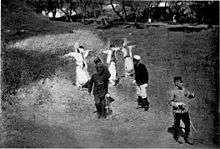
Within Korea itself, anti-Japanese rallies continued on occasion. Most notably, the Gwangju Students Anti-Japanese Movement on 3 November 1929 led to the strengthening of Japanese military rule in 1931, after which freedom of the press and freedom of expression were curbed. Many witnesses, including Catholic priests, reported that Japanese authorities dealt with insurgency severely. When villagers were suspected of hiding rebels, entire village populations are said to have been herded into public buildings (especially churches) and massacred when the buildings were set on fire.[79] In the village of Jeam-ni, Hwaseong, for example, a group of 29 people were gathered inside a church which was then set afire.[80] Such events deepened the hostility of many Korean civilians towards the Japanese government.
On 10 December 1941, the Provisional Government of the Republic of Korea, under the presidency of Kim Gu, declared war on Japan and Germany. Kim Gu organized many of the exiled Korean resistance groups, forming the "Korean Liberation Army". On the other hand, Kim Il-sung led tens of thousands of Koreans who volunteered for the National Revolutionary Army and the People's Liberation Army. The communist-backed Korean Volunteer Army (KVA, 조선의용군, 朝鮮義勇軍) was established in Yenan, China, outside of the Provisional Government's control, from a core of 1,000 deserters from the Imperial Japanese Army. After the Manchurian Strategic Offensive Operation, the KVA entered Manchuria, where it recruited from the ethnic Korean population and eventually became the Korean People's Army of the Democratic People's Republic of Korea.
Economy and exploitation
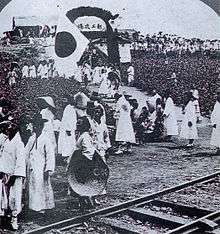

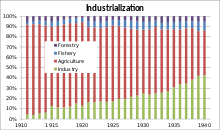
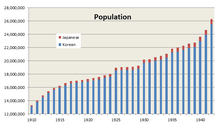
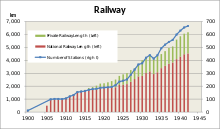
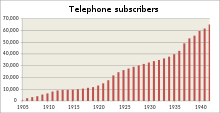
Economic output in terms of agriculture, fishery, forestry and industry increased by tenfold from 1910 to 1945 as illustrated on the chart to the right.[81] Princeton's Atul Kohli concluded that the economic development model the Japanese instituted played the crucial role in Korean economic development, a model that was maintained by the Koreans in the post-World War II era.[82]
Randall S. Jones wrote that "economic development during the colonial period can be said to have laid the foundation for future growth in several respects."[83] According to Myung Soo Cha of Yeungnam University, "the South Korean developmental state, as symbolized by Park Chung Hee, a former officer of the Japanese Imperial army serving in wartime Manchuria, was closely modeled upon the colonial system of government. In short, South Korea grew on the shoulders of the colonial achievement, rather than emerging out of the ashes left by the Korean War, as is sometimes asserted."[84]
A 2017 study found that the gradual removal of trade barriers (almost fully completed by 1923) after Japan's annexation of Korea "increased population growth rates more in the regions close to the former border between Japan and Korea than in the other regions. Furthermore, after integration, the regions close to Korea that specialized in the fabric industry, whose products were the primary goods exported from Japan to Korea, experienced more population growth than other regions close to Korea did."[85]
There were some modernization efforts by the late 19th century prior to annexation. Seoul became the first city in East Asia to have electricity, trolley cars, water, telephone, and telegraph systems all at the same time,[11] but Korea remained a largely backward agricultural economy around the start of the 20th century.[86] "Japan's initial colonial policy was to increase agricultural production in Korea to meet Japan's growing need for rice. Japan also began to build large-scale industries in Korea in the 1930s as part of the empire-wide program of economic self-sufficiency and war preparation."[87][88] In terms of exports, "Japanese industry as a whole gained little ... and this is certainly true for the most important manufacturing sector, cotton textiles. This export trade had little impact, positive or negative, on the welfare of Japanese consumer."[89] Likewise in terms of the profitability of Japanese investors: colonial Korea made no significant impact.[90]
According to scholar Donald S. Macdonald, "for centuries most Koreans lived as subsistence farmers of rice and other grains and satisfied most of their basic needs through their own labor or through barter. The manufactures of traditional Korea – principally cloth, cooking and eating utensils, furniture, jewelry, and paper – were produced by artisans in a few population centers."[86]
During the early period of Japanese rule, the Japanese government attempted to completely integrate the Korean economy with Japan, and thus introduced many modern economic and social institutions and invested heavily in infrastructure, including schools, railroads and utilities. Most of these physical facilities remained in Korea after the Liberation. The Japanese government played an even more active role in developing Korea than it had played in developing the Japanese economy in the late nineteenth century. Many programs drafted in Korea in the 1920s and 1930s originated in policies drafted in Japan during the Meiji period (1868–1912). The Japanese government helped to mobilize resources for development and provided entrepreneurial leadership for these new enterprises. Colonial economic growth was initiated through powerful government efforts to expand the economic infrastructure, to increase investment in human capital through health and education and to raise productivity.[86]
However, under Japanese rule, many Korean resources were only used for Japan.[13] Economist Suh Sang-chul points out that the nature of industrialization during the period was as an "imposed enclave", so the impact of colonialism was trivial. Another scholar, Song Byung-nak, states that the economic condition of average Koreans deteriorated during the period despite the economic growth. Most Koreans at the time could access only a primary school education under restriction by the Japanese, and this prevented the growth of an indigenous entrepreneurial class. A 1939 statistic shows that among the total capital recorded by factories, about 94 percent was Japanese-owned. While Koreans owned about 61 percent of small-scale firms that had 5 to 49 employees, about 92 percent of large-scale enterprises with more than 200 employees were Japanese-owned.[91][92][93]
Virtually all industries were owned either by Japan-based corporations or by Japanese corporations in Korea. As of 1942, indigenous capital constituted only 1.5 percent of the total capital invested in Korean industries. Korean entrepreneurs were charged interest rates 25 percent higher than their Japanese counterparts, so it was difficult for large Korean enterprises to emerge. More and more farmland was taken over by the Japanese, and an increasing proportion of Korean farmers either became sharecroppers or migrated to Japan or Manchuria as laborers. As greater quantities of Korean rice were exported to Japan, per capita consumption of rice among the Koreans declined; between 1932 and 1936, per capita consumption of rice declined to half the level consumed between 1912 and 1916. Although the government imported coarse grains from Manchuria to augment the Korean food supply, per capita consumption of food grains in 1944 was 35 percent below that of 1912 to 1916.[87]
The Japanese government created a system of colonial mercantilism, requiring construction of significant transportation infrastructure on the Korean Peninsula for the purpose of extracting and exploiting resources such as raw materials (timber), foodstuff (mostly rice and fish), and mineral resources (coal and iron ore). The Japanese developed port facilities and an extensive railway system which included a main trunk railway from the southern port city of Pusan through the capital of Seoul and north to the Chinese border. This infrastructure was intended not only to facilitate a colonial mercantilist economy, but was also viewed as a strategic necessity for the Japanese military to control Korea and to move large numbers of troops and materials to the Chinese border at short notice.
From the late 1920s and into the 1930s, particularly during the tenure of Japanese Governor-General Kazushige Ugaki, concentrated efforts were made to build up the industrial base in Korea. This was especially true in the areas of heavy industry, such as chemical plants and steel mills, and munitions production. The Japanese military felt it would be beneficial to have production closer to the source of raw materials and closer to potential front lines for a future war with China.[94]
Lee Young-hoon, a professor at Seoul National University states that less than 10% of arable land actually came under Japanese control and rice was normally traded, not robbed. He also insists that Koreans' knowledge about the era under Japanese rule is mostly made up by later educators.[95][96][97][98] Many of Lee's arguments, however, have been contested.[99]
According to Alleyne Ireland, a British author, he referred to condition of Korea under Japanese rule. As of 1926, he described on his book "The New Korea", "looking forward from 1910, one thing was clear where many things were obscure, namely that Japan, having decided to make Korea part of her Empire, would deem the permanence of her occupation to be a major element of her national policy, to be held intact, at whatever cost, against internal revolt or foreign intrigue.[100] The Japanese refer with pride to their effective protection of life and property throughout a country but recently overrun by bandits, to the enormous increase during the past fifteen years in every branch of production, with its connotation of increased employment for Koreans, to the constantly mounting number of Koreans appointed to the government service are facts, that cannot be gainsaid. However, the Korean nationalists attribute to them a sinister significance."[101]
Changes to Korean culture under Japanese rule
Newspaper censorship
In 1907, the Japanese government passed the Newspaper Law which effectively prevented the publication of local papers. Only the Korean-language newspaper Taehan Maeil Sinbo (大韓每日新報) continued its publication, because it was run by a foreigner named Ernest Bethell. For the first decade of colonial rule, therefore, there were no Korean-owned newspapers whatsoever, although books were steadily printed and there were several dozen Korean-owned magazines.[102] In 1920 these laws were relaxed, and in 1932 Japan eliminated a significant double standard which had been making Korean publication significantly more difficult than Japanese publication. Even with these relaxed rules, however, the government still seized newspapers without warning: there are over a thousand recorded seizures between 1920 and 1939. Revocation of publishing rights was relatively rare, and only three magazines had their rights revoked over the entire colonial period. In 1940, as the Pacific War increased in intensity, Japan shut down all Korean language newspapers again.[102]
Education
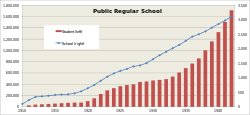

Following the annexation of Korea, the Japanese administration introduced a free public education system modeled after the Japanese school system with a pyramidal hierarchy of elementary, middle and high schools, culminating at the Keijō Imperial University in Seoul. As in Japan itself, education was viewed primarily as an instrument of "the Formation of the Imperial Citizen" (황민화; 皇民化; Hwangminhwa) with a heavy emphasis on moral and political instruction. Japanese religious groups such as Protestant Christians willingly supported the Japanese authorities in their effort to assimilate Koreans through education.[103]
During colonial times, elementary schools were known as "Citizen Schools" (국민학교; 國民學校; gungmin hakgyo) as in Japan, as a means of forming proper "Imperial Citizens" (황국민; 皇國民; Hwanggungmin) from early childhood. Elementary schools in South Korea today are known by the name chodeung hakgyo (초등학교; 初等學校) ("elementary school") as the term gungmin hakgyo has recently become a politically incorrect term.
During colonialism period, Japan established an equal educational system in Korea, but it strictly limited the rate of coed education. After the Korean Educational Ordinance was published in 1938, this situation has changed slightly. "Primary education consisted of a mandated four years of primary school (futsu gakkō). Secondary education included four years of middle school for boys (koto futsu gakko) and three years for girls (joshi koto futsu gakko) or two to three years of vocational school (jitsugyo gakkō). 1915, the Japanese announced the Regulations for Technical Schools (Senmon gakko kisoku), which legalized technical schools (senmon gakko) as post-secondary educational institutions."[104]
Besides, the Korean modern educational institutions were excluded from the colonial system. 1911, Japanese government set The Regulations for Private Schools (Shiritsu gakko kisoku) and destroy these facilities which showed patriotic awakening.[105]
The public curriculum for most of the period was taught by Korean educators under a hybrid system focused on assimilating Koreans into the Japanese empire while emphasizing Korean cultural education. This focused on the history of the Japanese Empire as well as inculcating reverence for the Imperial House of Japan and instruction in the Imperial Rescript on Education.
Integration of Korean students in Japanese language schools and Japanese students in Korean language schools was discouraged but steadily increased over time. While official policy promoted equality between ethnic Koreans and ethnic Japanese, in practice this was rarely the case.[106] Korean history and language studies would be taught side by side with Japanese history and language studies until the early 1940s under a new education ordinance that saw wartime efforts increased and the hybrid system slowly weakened.[107]
One point of view is that, although the Japanese education system in Korea was detrimental towards the colony's cultural identity, its introduction of public education as universal was a step in the right direction to improve Korea's human capital. Towards the end of Japanese rule, Korea saw elementary school attendance at 38 percent. Children of elite families were able to advance to higher education, while others were able to attend technical schools, allowing for "the emergence of a small but important class of well-educated white collar and technical workers ... who possessed skills required to run a modern industrial economy." The Japanese education system ultimately produced hundreds of thousands of educated South Koreans who later became "the core of the postwar political and economic elite."[108]
Another point of view is that it was only after the end of Japanese rule with World War II that Korea saw true, democratic rise in public education as evidenced by the rise of adult literacy rate from 22 percent in 1945 to 87.6 percent by 1970 and 93% by the late 1980s. Though free public education was made available for elementary schools during Japanese rule, Korea as a country did not experience secondary-school enrollment rates comparable to those of Japan prior to the end of World War II.[109]
Japanese policies for the Korean language
In the initial phase of Japanese rule, students were taught in Korean in public schools established by ethnic Korean officials who worked for the colonial government. While prior to this schools in Korea had used mostly Hanja, during this time Korean came to be written in a mixed Hanja–Korean script influenced by the Japanese writing system, where most lexical roots were written in Hanja and grammatical forms in Korean script.[110] Korean textbooks from this era included excerpts from traditional Korean stories such as Heungbujeon (흥부전).[111]
In 1921, government efforts were strengthened to promote Korean media and literature throughout Korea and also in Japan. The Japanese government also created incentives to educate ethnic Japanese students in the Korean language.[112] As a response, the Korean Language Society was created by ethnic Koreans. In 1928, as the assimilation policy began to ramp up, the first Hangul Day (9 October) was celebrated to commemorate the Korean alphabet.[113]
The Japanese administrative policy shifted more aggressively towards cultural assimilation in 1938 (Naisen ittai) with a new government report advising reform to strengthen the war effort. This left less room for Korean language studies and by 1943 all Korean language courses had been phased out. Teaching and speaking of Korean was prohibited.[114] Although the government report advised further, more radical reform, the 10-year plan would never fully go into effect.[115]
Removal and return of historical artifacts
The Japanese rule of Korea also resulted in the theft of tens of thousands of cultural artifacts to Japan. The issue over where these articles should be located began during the U.S. occupation of Japan.[116] In 1965, as part of the Treaty on Basic Relations between Japan and the Republic of Korea, Japan returned roughly 1,400 artifacts to Korea, and considered the diplomatic matter to have been resolved.[117] Korean artifacts are retained in the Tokyo National Museum and in the hands of many private collectors.[118]
According to the South Korean government, there are 75,311 cultural artifacts that were taken from Korea. Japan has 34,369, the United States has 17,803,[119] and France had several hundred, which were seized in the French campaign against Korea and loaned back to Korea in 2010 without an apology.[120] In 2010, Prime Minister of Japan Naoto Kan expressed "deep remorse" for the removal of artifacts,[121] and arranged an initial plan to return the Royal Protocols of the Joseon Dynasty and over 1,200 other books, which was carried out in 2011.[122]
Anthropology and religion
Japan sent anthropologists to Korea who took photos of the traditional state of Korean villages, serving as evidence that Korea was "backwards" and needed to be modernized.[123]
As Japan established the puppet state of Manchukuo, Korea became more vital to the internal communications and defense of the Japanese empire against the Soviet Union. Japan decided in the 1930s to make the Koreans become more loyal to the Emperor by requiring Korean participation in the State Shinto devotions, and by weakening the influences of both Christianity and traditional religion.[5][124]
The primary building of Gyeongbokgung palace was demolished and the Japanese General Government Building was built in its exact location. The Japanese colonial authorities destroyed 85 percent of all the buildings in Gyeongbokgung.[125] Sungnyemun, the gate in Seoul that was an iconic symbol of Korea, was altered by the addition of large, Shinto-style golden horns near the roofs (later removed by the South Korean government after independence).
Christianity and Communism
Protestant missionary efforts in Asia were nowhere more successful than in Korea. American Presbyterians and Methodists arrived in the 1880s and were well received. In the days Korea was under Japanese control, Christianity became in part an expression of nationalism in opposition to Japan's efforts to promote the Japanese language and the Shinto religion.[126] In 1914, out of 16 million people, there were 86,000 Protestants and 79,000 Catholics; by 1934 the numbers were 168,000 and 147,000. Presbyterian missionaries were especially successful. Harmonizing with traditional practices became an issue. The Catholics tolerated Shinto rites. The Protestants developed a substitute for Confucian ancestral rites by merging Confucian-based and Christian death and funerary rituals.[127]
Missionaries, however, were alarmed at the rise in communist activity during the 1920s. Communist literature was effectively banned in Korea at this time, but it was sometimes smuggled into the country disguised as Christian literature, often addressed to missionaries to further avoid suspicion. Communist concepts, such as class struggle, and its partner nationalist movement were resonating well with some of the peasants and lower-class citizens of colonial-era Korea; this was worrying to some missionaries because of communism's atheist components. At one point, communist students in Seoul held an "anti-Sunday School conference" and loudly protested religion in front of churches. This protest renewed Japanese governmental interest in censorship of communist ideas and language.[128]
Legacy
Many Koreans became victims of Japanese brutalities during the colonial period. Korean villagers hiding resistance fighters were dealt with harshly, often with summary execution, rape, forced labour, and looting.[129][130][131][132][133][134] Starting on 1 March 1919, an anti-Japanese demonstration continued to spread, and as the Japanese national and military police could not contain the crowds, the army and even the navy were also called in. There were several reports of atrocities. In one instance, Japanese police in the village of Jeam-ri, Hwaseong herded everyone into a church, locked it, and burned it to the ground. They also shot through the burning windows of the church to ensure that no one made it out alive. Many participants of the 1 March Movement were subjected to torture and execution.
Result of the name changes
Although officially voluntary, and initially resisted by the Japanese Colonial Government, 80% of Koreans voluntarily changed their name to Japanese in 1940. Many community leaders urged the adoption of Japanese names to make it easy for their children to succeed in society and overcome discrimination.[135]
A study conducted by the United States Library of Congress states that "the Korean culture was quashed, and Koreans were required to speak Japanese and take Japanese names".[136][137][138] This name change policy, called Changssi-gaemyeong (창씨개명; 創氏改名) (also known as sōshi-kaimei), was part of Japan's assimilation efforts.[139][140] This was heavily resisted by the Korean people. Those Koreans who retained their Korean names were not allowed to enroll at school, were refused service at government offices, and were excluded from the lists for food rations and other supplies. Faced with such compulsion, many Koreans ended up complying with the Name Change Order. Such a radical policy was deemed to be symbolically significant in the war effort, binding the fate of the colony with that of the empire.[141] A number of prominent ethnic Koreans working for the Japanese government, including General Hong Sa-ik, insisted on keeping their Korean names. Another ethnic Korean, Park Chun-Geum (박춘금, 朴春琴), was elected as a member of the Lower House from the Tokyo Third District in the general election in 1932 and served two terms without changing his Korean name, but has been registered as chinilpa by the current Republic of Korea government.
Forced laborers and comfort women
During World War II, about 450,000 Korean male laborers were involuntarily sent to Japan.[142] Comfort women, who served in Japanese military brothels as a form of sexual slavery, came from all over the Japanese empire. Historical estimates range from 10,000 to 200,000, including an unknown number of Koreans. However, 200,000 is considered to be a conservative number by modern historians, and up to 500,000 comfort women are estimated to be taken.[143][144] These women faced an average of 29 men and up to 40 men per day, according to one surviving comfort woman.[145] However, of the 500,000, less than 50 are alive today. Comfort women were often recruited from rural locales with the promise of factory employment; business records, often from Korean subcontractees of Japanese companies, showed them falsely classified as nurses or secretaries.[146] There is evidence that the Japanese government intentionally destroyed official records regarding comfort women.[147][148]
In 2002, South Korea started an investigation of Japanese collaborators. Part of the investigation was completed in 2006 and a list of names of individuals who profited from exploitation of fellow Koreans were posted.[149] The collaborators not only benefited from exploiting their countrymen, but the children of these collaborators benefited further by acquiring higher education with the exploitation money they had amassed.[150]
The "Truth Commission on Forced Mobilization under the Japanese Imperialism Republic of Korea" investigated the received reports for damage from 86 people among the 148 Koreans who were accused of being the level B and C war criminals while serving as prison guards for the Japanese military during World War II. The commission, which was organized by the South Korean government, announced that they acknowledge 83 people among them as victims. The commission said that although the people reluctantly served as guards to avoid the draft, they took responsibility for mistreatment by the Japanese against prisoners of war. Lee Se-il, leader of the investigation, said that examination of the military prosecution reports for 15 Korean prison guards, obtained from The National Archives of the United Kingdom, confirmed that they were convicted without explicit evidence.[151]
Koreans in Unit 731
Koreans, along with many other Asians, were experimented on in Unit 731, a secret military medical experimentation unit in World War II. The victims who died in the camp included at least 25 victims from the former Soviet Union and Korea.[152] General Shiro Ishii, the head of Unit 731, revealed during the Tokyo War Crime Trials that 254 Koreans were killed in Unit 731.[153] Some historians estimate up to 250,000 total people were subjected to human experiments.[154] A Unit 731 veteran attested that most that were experimented on were Chinese, Koreans and Mongolians.[155]
Discrimination against Korean leprosy patients by Japan
Colonial Korea was subject to the same Leprosy Prevention Laws of 1907 and 1931 as the Japanese home islands. These laws directly and indirectly permitted the quarantine of patients in sanitariums, where forced abortions and sterilization were common. The laws authorized punishment of patients "disturbing the peace", as most Japanese leprologists believed that vulnerability to the disease was inheritable.[156] In Korea, many leprosy patients were also subjected to hard labor.[157] The Japanese government compensated inpatients.[158]
Atomic bomb casualties
Many Koreans were drafted for work at military industrial factories in Hiroshima and Nagasaki.[52] According to the secretary-general of a group named Peace Project Network, "there were a total of 70,000 Korean victims in both cities". Japan paid South Korea 4 billion yen and built a welfare center in the name of humanitarian assistance, not as compensation to the victims.[53]
Japanese post-colonial responses
South Korean presidential investigation commission on pro-Japanese collaborators
Collaborators of the Imperial Japanese Army were prosecuted in the postwar period as Chinilpa, or "friendly to Japanese".[159] In 2006 South Korean president Roh Moo-hyun appointed an investigation commission into the issue of locating descendants of pro-Japanese collaborators from the times of the 1890s until the collapse of Japanese rule in 1945.
In 2010, the commission concluded its five-volume report. As a result, the land property of 168 South Korean citizens has been confiscated by the government, these citizens being descendants of pro-Japanese collaborators.[160] Despite the fact that Samsung was founded in 1938 by Lee Byung-chul, a member of a wealthy Korean family in Japanese controlled Korea and a student at Waseda University (Tokyo), he was somehow spared from being branded a pro-Japanese collaborator. Japanese collaborators spread culture of torture and dictatorship in military and school and other parts of society.[161][162][163]
In popular culture
- Madam Oh, 1965 South Korean film
- Femme Fatale: Bae Jeong-ja, 1973 South Korean film
- Mulberry, 1986 South Korean film
- Modern Boy, 2008 South Korean film
- My Way, 2011 South Korean film
- Bridal Mask, 2012 South Korean TV drama
- Assassination, 2015 South Korean film
- The Silenced, 2015 South Korean film
- Spirits' Homecoming, 2016 South Korean film
- The Handmaiden, 2016 South Korean film
- The Last Princess, 2016 South Korean film
- The Age of Shadows, 2016 South Korean film
- Love Lies, 2016 South Korean film
- Chicago Typewriter, 2017 South Korean TV show
- Battleship Island, 2017 South Korean film
- Anarchist from Colony, 2017 South Korean film
- Mr. Sunshine, 2018 South Korean TV show
- Pachinko, 2017 novel by Min Jin Lee
- The Hymn of Death, 2018 South Korean TV show
- Different Dreams, 2019 South Korean TV show
- The Battle: Roar to Victory, 2019 South Korean film
List of Governors-General of Korea
Below is a list of Governors-General of Korea under Japanese rule:
- Terauchi Masatake (1910–1916)
- Hasegawa Yoshimichi (1916–1919)
- Saitō Makoto (1919–1927, 1929–1931)
- Yamanashi Hanzō (1927–1929)
- Kazushige Ugaki (1927, 1931–1936)
- Jirō Minami (1936–1942)
- Kuniaki Koiso (1942–1944)
- Nobuyuki Abe (1944–1945)
References

- Sarah Thal. "A Religion That Was Not a Religion: The Creation of Modern Shinto in Nineteenth-Century Japan". In The Invention of Religion., eds. Peterson and Walhof (New Brunswick, NJ: Rutgers University Press, 2002). pp. 100–114.
- Hitoshi Nitta. "Shintō as a ‘Non-Religion’: The Origins and Development of an Idea". In Shintō in History: Ways of the Kami, eds. Breen and Teeuwen (Honolulu: University of Hawai’i, 2000).
- John Breen, "Ideologues, Bureaucrats and Priests", in Shintō in History: Ways of the Kami.
- Hitoshi Nitta. The Illusion of "Arahitogami" "Kokkashintou". Tokyo: PHP Kenkyūjo, 2003.
- Wi Jo Kang (1997). Christ and Caesar in Modern Korea: A History of Christianity and Politics. SUNY Press. p. 62. ISBN 9780791432488.
- The Abacus and the Sword; Duus, Peter; Univ of California Press, 1995; pp. 18–24
- Yutaka, Kawasaki (7 August 1996). "Was the 1910 Annexation Treaty Between Korea and Japan Concluded Legally?". Murdoch University Electronic Journal of Law. Retrieved 19 February 2007.
- "Treaty of Annexation". USC-UCLA Joint East Asian Studies Center. Archived from the original on 11 February 2007. Retrieved 19 February 2007.
- Jae-gon Cho The Industrial Promotion Policy and Commercial Structure of the Taehan Empire. Seoul: Jimoondang Publishing Company (2006)
- D.W. Shin, S.I. Hwang (1996). The Historical Interpretation on the Formation of the Modern Health Care System in Late Choson.
- "Summer Institute Summaries". Archived from the original on 12 August 2013. Retrieved 5 January 2015.
- Hook, Glenn D. (2001). Japan's International Relations: Politics, Economics, and Security,; p. 491 at Google Books.
Article II. It is confirmed that all treaties or agreements concluded between the Empire of Japan and the Empire of Korea on or before August 22, 1910 are already null and void.
External link in|title=(help) - Lee, Jong-Wha. "Economic Growth and human Production in the Republic of Korea, 1945–1992" (PDF). United Nations Development Programme. Retrieved 19 February 2007.
- A reckless adventure in Taiwan amid Meiji Restoration turmoil, THE ASAHI SHIMBUN, Retrieved on 22 July 2007. Archived 31 October 2007 at the Wayback Machine
- Altman, Albert A. (1984). "Korea's First Newspaper: The Japanese Chōsen shinpō". The Journal of Asian Studies. 43 (4): 685–696. doi:10.2307/2057150. JSTOR 2057150.
- Marius B. Jansen (April 1989). The Cambridge History of Japan Volume 5 The Nineteenth Century. Cambridge University Press ISBN 0-521-22356-3.
- Japanese Cabinet Meeting document Nov, 1882 Archived 13 April 2009 at the Wayback Machine p.6 left 陸軍外務両者上申故陸軍工兵中尉堀本禮造外二名並朝鮮国二於テ戦死ノ巡査及公使館雇ノ者等靖国神社ヘ合祀ノ事
- Japanese Cabinet Meeting document Nov, 1882 Archived 13 April 2009 at the Wayback Machine p.2 left
- 国立公文書館 アジア歴史資料センター. Archived from the original on 16 January 2015. Retrieved 5 January 2015.
- Park Jong-hyo (박종효) former professor at Lomonosov Moscow State University (1 January 2002). 일본인 폭도가 가슴을 세 번 짓밟고 일본도로 난자했다. Dong-a Ilbo (in Korean) (508): 472 ~ 485.
- See Russian eyewitness account of surrounding circumstances at "Archived copy". Archived from the original on 1 February 2016. Retrieved 3 August 2014.CS1 maint: archived copy as title (link) by Gari Ledyard, Sejong Professor of Korean History Emeritus at Columbia University
- Anglo-Japanese Gazette; London October 1904
- Hadar, Oren. "South Korea; The Choson Dynasty". Library of Congress Country Studies. Retrieved 20 February 2007.
- Dept of State Correspondence #856 dtd 6 January 1905
- Hulbert, H. B. (1999). History of Korea. Routledge. ISBN 978-0-7007-0700-3.
- Keene, D. (2005). Emperor of Japan: Meiji and His World, 1852–1912. Columbia University Press. ISBN 978-0-231-12340-2.
- "韓日 지식인 "1910년 한일병합조약 무효"..공동선언".
- "'한일병합 무효' 입증 문건 처음으로 확인".
- "[인터뷰] '한일병합 무효' 근거 제공 이태진 서울대 명예교수".
- The Historical Experience of Agrarian Reform in Our Country. Pyongyang. 1974. pp. 6–7.
- McCune, Shannon (1964). Korea's Heritage. Rutland: Charles Tuttle. p. 86.
- McCune, Shannon (1974). The Historical Experience of Agrarian Reform in Our Country. Pyongyang. p. 7.
- Grajdanzev, Andrew J. (1944). Modern Korea. New York. p. 118.
- Nozaki, Yoshiko; Hiromitsu Inokuchi; Tae-young Kim. "Legal Categories, Demographic Change and Japan's Korean Residents in the Long Twentieth Century". Archived from the original on 25 January 2007. Retrieved 19 February 2007.
- "Hakoishi report" 韓国・国史編纂委員会所蔵 (in Japanese). Historiographical Institute of the University of Tokyo. Retrieved 8 September 2008.
第一条 朝鮮史編修会ハ朝鮮総督ノ管理ニ属シ朝鮮史料ノ蒐集及編纂並朝鮮史ノ編修ヲ掌ル
- 조선사편수회. Naver/Doosan Encyclopedia (in Korean).
- E. Taylor Atkins (10 July 2010). Primitive Selves: Koreana in the Japanese Colonial Gaze, 1910–1945. University of California Press. pp. 177–180. ISBN 978-0-520-94768-9.
- Metropolitan Museum of Art
- 리순진 (2001). 평양일대 락랑무덤에 대한 연구 [A Research about the Tombs of Nangnang around Pyongyang]. 서울: 중심. ISBN 978-89-89524-05-2.
- "history of the museum" (in Korean). National Palace Museum of Korea website. Archived from the original on 3 March 2016. Retrieved 24 April 2008.
- Ohashi Toshihiro. "A Study on the Development of the Cultural Properties Policy in Korea from 1902 until 1962". Sogo Seisaku Ronso 8 (2004)
- 日本外交文書デジタルアーカイブ 昭和期I第1部 第5巻 p248
- Em, Henry (2013). The Great Enterprise: Sovereignty and Historiography in Modern Korea, Part 2. Durham: Duke University Press. p. 125. ISBN 978-0822353720. Retrieved 21 August 2017.
- Mizuno, Naoki. 植民地支配と「人の支配」 [Colonial control and "human control"] (PDF). Kyoto University. Archived from the original (PDF) on 3 January 2007. Retrieved 20 February 2007. Cite journal requires
|journal=(help) - 윤해동. 황국신민화정책자료해설 (in Korean). Archived from the original on 28 September 2007. Retrieved 19 February 2007.
- 水野直樹「『創氏改名』の実施過程について」『朝鮮史研究会会報』154号、2004年 (in Japanese).
- Myers, Brian R. (2011). The Cleanest Race: How North Koreans See Themselves – And Why It Matters (Paperback ed.). Melville House. pp. 26–29.
- Ryang, Sonia (2000). "The North Korean homeland of Koreans in Japan". In Ryang, Sonia (ed.). Koreans in Japan: Critical Voices from the Margin. Taylor & Francis. ISBN 978-1-136-35312-3.
- Rummel, R. J., Death by Government, pg.150
- Rummel, R. J. (1999). Statistics of Democide: Genocide and Mass Murder Since 1990. Lit Verlag. ISBN 978-3-8258-4010-5. Available online: "Statistics of Democide: Chapter 3 – Statistics Of Japanese Democide Estimates, Calculations, And Sources". Freedom, Democracy, Peace; Power, Democide, and War. Retrieved 1 March 2006.
- Lankov, Andrei (5 January 2006). "Stateless in Sakhalin". The Korea Times. Retrieved 26 November 2006.
- "Japan compensates Korean A-bomb victim". BBC News. 1 June 2001. Retrieved 26 September 2009.
- Andreas Hippin (2 August 2005). "The end of silence: Korea's Hiroshima, Korean A-bomb victims seek redress". The Japan Times.
- 太平洋戦争下の朝鮮及び台湾、友邦協会、1961, p. 191.
- Kratoska, Paul H. (2006). Asian Labor in the Wartime Japanese Empire. NUS Press. p. 115. ISBN 978-9971693336.
- "Current state of Korea and Taiwan: Imperial Army Special volunteer system". administrative bureau. October 1943. p. 13. Archived from the original on 18 October 2015.
- "Evidence of Park Chung-hee's military allegiance to Japan surfaces". The Hankyoreh. 6 November 2009.
- ko:일본 육군사관학교
- ko:조성근 (1876년)
- ko:왕유식
- ko:이병무
- ko:이희두
- ko:김응선
- "육군 참모총장, The Republic of Korea Army" (in Korean). Retrieved 19 February 2007.
- 초기 육군 총장들은 일본 육사 출신, 여야 설전. CBS Nocut News/Naver (in Korean). 26 September 2005. Archived from the original on 12 July 2012. Retrieved 19 February 2007.
- Philip S. Jowett (2004). Rays of the Rising Sun. West Midlands: Helion & Company Limited. p. 34.
- "Archived copy". Archived from the original on 13 April 2016. Retrieved 20 August 2015.CS1 maint: archived copy as title (link)
- "Pride and Patriotism: Stamford's Role in World War II: The Battle of Tarawa".
- "The Battle of Tarawa, November 20–24, 1943". World War II Multimedia Database.
- Gavan Daws (1994). Prisoners of the Japanese: POWs of World War II in the Pacific. New York: William Morrow & Company. p. 278. ISBN 978-0-688-11812-9.
- B. V. A Roling and Antonio Cassese (1993). The Tokyo Trial and Beyond. Oxford, UK: Polity Press. p. 76.
- "Blood Brothers A Medic's Sketch Book / Jacobs, Colonel Eugene C." Project Gutenberg. Archived from the original on 6 May 2008.
- Jacobs, Eugene C. (1985). Blood brothers: a medic's sketch book. Carlton Press. ISBN 978-0-8062-2300-1.
- "Bridge Over the River Kwai – Chapter 8". Mekong Express. Archived from the original on 28 August 2008.
- Fukuoka, Yasunori (1996). "Beyond Assimilation and Dissimilation: Diverse Resolutions to Identity Crises among Younger Generation Koreans in Japan". Saitama University. Retrieved 27 November 2006. Cite journal requires
|journal=(help) - Lee, Ki-Baik (1999). A New History of Korea (韓国史新論). Translated by Wagner, Edward W. with Edwar J. Shultz. Ilchorak/Harvard University Press. pp. 1080. ISBN 978-0-674-61575-5.
- "March First Movement". Encyclopædia Britannica Premium Service. Retrieved 1 March 2006.
- French, Paul. North Korea: The Paranoid Peninsula – A Modern History. 2nd ed. New York: Zed Books, 2007. 50–51. Print.
- Wells, Kenneth M. (1989). Background to the March First Movement: Koreans in Japan, 1905–1919. Korean Studies, V. 13, 1989. pp. 1–21.
- Lee, Ki-Baik (1999). A New History of Korea (韓国史新論). Translated by Wagner. with Edwar J. Shultz. Ilchorak/Harvard University Press. pp. 344. ISBN 978-0-674-61575-5.
- "朝鮮総督府統計年報 昭和17年 [Governor-General of Korea Statistical Yearbook 1942]". Governor-General of Korea. March 1944.
- Kohli, Atul (2004). State-Directed Development: Political Power and Industrialization in the Global Periphery. Cambridge: Cambridge University Press. p. 27, 56.
[T]he Japanese made extensive use of state power for their own economic development and then used the same state power to pry open and transform Korea in a relatively short period of time. . . . The highly cohesive and disciplining state that the Japanese helped to construct in colonial Korea turned out to be an efficacious economic actor. The state utilised its bureaucratic capacities to undertake numerous economic tasks: collecting more taxes, building infrastructure, and undertaking production directly. More important, this highly purposive state made increasing production one of its priorities and incorporated property-owning classes into production-oriented alliances.
- Randall S. Jones. The economic development of colonial Korea. University of Michigan, 1984. p. 168.
- Myung Soo Cha. "The Economic History of Korea Archived December 12, 2011, at the Wayback Machine". Online Encyclopedia of Economic History. Economic History Association, 2010.
- Nakajima, Kentaro; Okazaki, Tetsuji (2018). "The expanding Empire and spatial distribution of economic activity: the case of Japan's colonization of Korea during the prewar period". The Economic History Review. 71 (2): 593–616. doi:10.1111/ehr.12535. ISSN 1468-0289.
- Savada, Andrea Matles; Shaw, William, eds. (1990). "A Country Study: South Korea, The Japanese Role in Korea's Economic Development". Federal Research Division, Library of Congress.
- Savada, Andrea Matles; Shaw, William, eds. (1990). "Korea Under Japanese Rule". Federal Research Division, Library of Congress.
- Kimura, Mitsuhiko (1995). "The Economics of Japanese Imperialism in Korea, 1910–1939". The Economic History Review. 48 (3): 555–574. doi:10.2307/2598181. JSTOR 2598181. See p. 558: "Japan faced shortages of rice as domestic production lagged behind demand. The government had three alternatives to deal with this problem: (a) increasing productivity of domestic agriculture, (b) importing foreign rice (gaimai) from south-east Asia, and (c) importing colonial rice. The first was most costly and its success was not assured. The second implied loss of foreign exchange and also dependence on foreign producers for the imperial staple, which would seriously weaken the political power of the empire vis-à-vis the West. It also involved a quality problem in that foreign rice of the indica variety did not suit Japanese taste. The third alternative seemed best to the Japanese administration."
- Kimura (1995), p. 557.
- Kimura (1995), p. 564.
- Cyhn, Jin W. (2002). Technology Transfer and International Production: The Development of the Electronics Industry in Korea. Cheltenham: Edward Elgar Publishing. p. 78.
- Suh, Sang-Chul (1978), Growth and Structural Changes in the Korean Economy, 1910–1940: The Korean. Economy under the Japanese Occupation, Harvard University Press, ISBN 0-674-36439-2
- Song, Byung-Nak (1997) The Rise of the Korean Economy. 2nd ed. Hong Kong; Oxford University Press. ISBN 0-19-590049-9
- Pratt, Keith (2007). Everlasting Flower: A History of Korea. Reaktion Books. ISBN 978-1-86189-335-2.
- Lee, Yong Hoon. "ソウル大教授「日本による収奪論は作られた神話」["It is a Myth Made up afterward that Japan Deprived Korea of Land and Food" Professor at Seoul University]". Registration required.
- "일제 토지ㆍ식량 수탈론은 상상된 신화". Hankooki.com. 18 November 2004. Archived from the original on 18 June 2013.
- Lee, Yong Hoon. "李栄薫教授「厳格なジャッジなき学界が歴史を歪曲」["Congress without Strict Judgment Distorts History" Lee Yong Hoon Professor]". Registration required.
- "정치 지도자의 잘못된 역사관이 나라 망치고있다". chosun.com. 31 May 2007.
- "Economic Growth and Human Development in the Republic of Korea, 1945-1992 - Human Development Reports". hdr.undp.org.
- Alleyne Ireland "The New Korea" E. P. Dutton. 1926 Chapter I Introductory pp. 2
- Alleyne Ireland "The New Korea" E. P. Dutton. 1926 Chapter I Introductory pp. 6
- Robinson, Michael E. (1987). Ramon H. Myers and Mark R. Peattie (ed.). The Japanese Colonial Empire, 1895–1945. Princeton University Press.
- Neuhaus, Dolf-Alexander (2016). "Assimilating Korea: Japanese Protestants, "East Asian Christianity" and the education of Koreans in Japan, 1905–1920". Paedagogica Historica. 52 (6): 614–628. doi:10.1080/00309230.2016.1224262.
- Solomon, Deborah B. (August 2014). "Colonial Rule and Social Change in Korea, 1910–1945. Edited by Hong Yung Lee, Yong-Chool Ha, and Clark W. Sorensen . Seattle: University of Washington Press, 2013. 350 pp. $45.00 (paper)". The Journal of Asian Studies. 73 (3): 827–829. doi:10.1017/s0021911814000837. ISSN 0021-9118.
- Lee, Jeong-Kyu (7 March 2002). "Japanese Higher Education Policy in Korea (1910—1945)". Education Policy Analysis Archives. 10: 14. doi:10.14507/epaa.v10n14.2002. ISSN 1068-2341.
- Caprio, Mark E (2009). "Post-March First Policy Reform and Assimilation". Japanese Assimilation Policies in Colonial Korea, 1910–1945. University of Washington Press. pp. 129–130. ISBN 978-0-295-98900-6.
- Caprio, Mark E (2009). "Radical Assimilation under Wartime Conditions". Japanese Assimilation Policies in Colonial Korea, 1910–1945. University of Washington Press. p. 153. ISBN 978-0-295-98900-6.
- ed. Duus, Peter, Ramon H. Myers, and Mark R. Peattie, The Japanese Wartime Empire, 1931–1945, Princeton University Press (1996), p. 326
- Andrea Matles Savada and William Shaw, editors. South Korea: A Country Study. Washington: GPO for the Library of Congress, 1990.
- Pratt, Rutt, Hoare, 1999. Korea: A Historical and Cultural Dictionary. Routledge.
- Hyŏng-gyu Pak. "Na ŭi midŭm ŭn kil wi e itta : Pak Hyŏng-gyu hoegorok". Seoul: Ch'angbi, 2010. ISBN 9788936471866
- Caprio, Mark E (2009). "Post-March First Policy Reform and Assimilation". Japanese Assimilation Policies in Colonial Korea, 1910–1945. University of Washington Press. pp. 128–129. ISBN 978-0-295-98900-6.
- Shin, Gi-Wook (2006). "Colonial Racism and Nationalism". Ethnic Nationalism in Korea: Genealogy, Politics, and Legacy. Stanford University Press. p. 51. ISBN 978-0-8047-5408-8.
- Hopfner, Jonathan (2009). Moon Living Abroad in South Korea. Berkeley, CA: Moon Publications. p. 25. ISBN 978-1-59880-250-4.
- Caprio, Mark E (2009). "Radical Assimilation under Wartime Conditions". Japanese Assimilation Policies in Colonial Korea, 1910–1945. University of Washington Press. p. 155. ISBN 978-0-295-98900-6.
- Macintyre, Donald (28 January 2002). "A Legacy Lost". TIME. ISSN 0040-781X. Retrieved 27 June 2009.
- Japan, Seoul sign deal on artifact returns 14 November 2010
- Itoi, Kay; Lee, B.J. (21 February 2005). "KOREA: A TUSSLE OVER TREASURES". Newsweek. ISSN 0028-9604. Retrieved 14 May 2011.
- Kim Hak-won (김학원) (17 October 2006). 해외 유출된 한국문화재 총 75,311점...문화재가 조국의 눈길한번 받지 못해. The Chosun Ilbo / newswire (in Korean). Archived from the original on 8 July 2011.
- Glionna, John M. (5 December 2010). "Recovering South Korea's lost treasures". Los Angeles Times. Retrieved 5 January 2015.
- Japan to Return Korea Artifacts in Occupation Apology Archived 15 September 2011 at the Wayback Machine Business Week 2010 08 10,
- Yoshihiro Makino. "Japan returns Korean royal archives after a century Archived 21 October 2012 at the Wayback Machine". Asahi Shimbun. 8 December 2011.
- Atkins, E. Taylor (2010). Primitive Selves: Koreana in the Japanese Colonial Gaze, 1910–1945'. Berkeley: University of California Press. ISBN 978-0-520-26674-2.
- Kenneth Scott Latourette, Christianity in a revolutionary age: A history of Christianity in the nineteenth and twentieth centuries, volume 5: The 20th Century Outside Europe (1962) pp 415–417
- Peter Bartholomew, 'Choson Dynasty Royal Compounds: Windows to a Lost Culture', in Transactions: Royal Asiatic Society, Korea Branch Vol. 68 (Seoul: RAS, 1993)
- Danielle Kane, and Jung Mee Park, "The Puzzle of Korean Christianity: Geopolitical Networks and Religious Conversion in Early Twentieth-Century East Asia", American Journal of Sociology (2009) 115#2 pp 365–404
- Kenneth Scott Latourette, A history of the expansion of Christianity Volume VII: Advance through Storm: A.D. 1914 and after, with concluding generalizations (1945) 7:401-7
- Suh, Dae-sook (1967), The Korean Communist Movement 1918–1948, Princeton, New Jersey: Princeton University Press, pp. 66–68
- The Korea Herald (27 December 2010). "Over 2,000 Koreans forced into labor camp in Siberia". Retrieved 5 January 2015.
- Ji-yoon, Lee (30 March 2010). "Comfort women issue is ongoing". The Korea Herald. Retrieved 10 August 2020.
- "일제강점기의 제3기 (Third period of Japanese forced occupation)" (in Korean). Naver.
- Global Security Watch-Korea William E. Berry, Jr., Prager security international 2008, ISBN 978-0-275-99484-6
- Kang Hyun-kyung (26 March 2010). "Colonial Victims of Japan's Payment Delinquencies to Be Compensated". Korea Times.
- Andrei Lankov (22 August 2010). "Korea became Japan's victim amid heydays of imperialism". Korea Times.
- Eckert, Carter J., Ki-baik Lee, Young Ick Lew, Michael Robinson, Edward W. Wagner, Korea Old and New: A History, pg.318
- "North Korea; The Rise of Korean Nationalism and Communism". June 1993. Retrieved 19 February 2007.
- "Part III: The problem from a historical perspective". Archived from the original on 31 December 2004. Retrieved 19 February 2007.
- Fukuoka, Yasunori. "Koreans in Japan: Past and Present". Saitama University Review. Retrieved 19 February 2007.
- "Japan's minorities yet to find their place in the sun". SAHRDC. Retrieved 19 February 2007.
- Stearns, Peter N. "The Encyclopedia of World History. 2001". Houghton Mifflin Company. Archived from the original on 4 February 2007. Retrieved 19 February 2007.
- Pak, Soon‐Yong; Hwang, Keumjoong (2011). "Assimilation and segregation of imperial subjects: "educating" the colonised during the 1910–1945 Japanese colonial rule of Korea". Paedagogica Historica. 47 (3): 377–397. doi:10.1080/00309230.2010.534104.
- Kim Seong-hwan (2004). 일제의 침략 전쟁과 병참기지화. SaKyejul. p. 173. ISBN 978-89-5828-032-3.
- "U.S. playwright takes up 'comfort women' cause". The Japan Times. 2005. Retrieved 1 March 2006.
- "Japan court rules against 'comfort women'". CNN.com. 29 March 2001. Archived from the original on 22 September 2006. Retrieved 1 March 2006.
- "Life as a "comfort woman": Survivors remember a WWII atrocity that was ignored for decades". 29 December 2015.
- Yun-deok, Kim (11 January 2005). "Military Record of 'Comfort Woman' Unearthed". The Chosun Ilbo. Archived from the original on 17 October 2006. Retrieved 19 February 2007.
- Horsley, William (9 August 2005). "Korean World War II sex slaves fight on". BBC News. Retrieved 19 February 2007.
- "Japan Boiled Comfort Woman to Make Soup". The Seoul Times. Retrieved 19 February 2007.
- "Archived copy". Archived from the original on 4 October 2012. Retrieved 4 April 2015.CS1 maint: archived copy as title (link)
- "Archived copy". Archived from the original on 4 October 2012. Retrieved 4 April 2015.CS1 maint: archived copy as title (link)
- Choe, Gwang-Suk (최광숙) (13 November 2006). 강제동원 ‘조선인 전범’ 오명 벗었다 [The forcefully mobilized Koreans cleared their disgrace as the war criminals.] (in Korean). Naver / Seoul Sinmun. Retrieved 1 December 2009.
- http://english.people.com.cn/200508/03/eng20050803_200004.html – Archives give up secrets of Japan's Unit 731. "The files include full descriptions of 318 cases, including at least 25 people from the former Soviet Union and Korea."
- http://www.instiz.net/pt/2647658 – KBS Special-Korean Victims of Unit 731. "General Shiro Ishii, the head of Unit 731, revealed during the Tokyo War Crime Trials that 254 Koreans were killed in Unit 731."
- https://www.theguardian.com/world/2011/feb/21/japan-excavates-site-human-experiments – Japan unearths site linked to human experiments. "Some historians estimate up to 250,000 people were subjected to human experiments."
- https://www.nytimes.com/1995/03/17/world/unmasking-horror-a-special-report-japan-confronting-gruesome-war-atrocity.html?pagewanted=1 – Unmasking Horror – A special report.; Japan Confronting Gruesome War Atrocity. "A Unit 731 veteran attested that most that were experimented on were Chinese, Koreans and Mongolians."
- Michio Miyasaka, A Historical and Ethical Analysis of Leprosy Control Policy in Japan, "Archived copy". Archived from the original on 13 November 2011. Retrieved 28 November 2011.CS1 maint: archived copy as title (link)
- Korean Hansens patients seek redress, http://search.japantimes.co.jp/cgi-bin/nn20040226a4.html
- 일제강점기 소록도 수용 한센인 590명, 日정부서 보상받아 - 연합뉴스
- Ko Wŏn-Sŏp. Panminnja Choesanggi (A record of charges against the anti-nationalists). Seoul: Paegyŏp Munhwasa, 1949.
- "South Korea targets Japanese collaborators' descendants" The Telegraph, 14 July 2010
- "<카드뉴스> 학교는 아직 일제강점기? 교육현장 속 일제 잔재 | 연합뉴스". Yna.co.kr. 15 August 2016. Retrieved 4 May 2020.
- http://sedo.or.kr/board/board_pds/pds_57/F49.pdf
- "광복군 동지애 사라지고 구타·왕따 日잔재 횡행 - 노컷뉴스". Nocutnews.co.kr. 18 August 2015. Retrieved 4 May 2020.
Further reading
- Brudnoy, David. "Japan's experiment in Korea." Monumenta Nipponica 25.1/2 (1970): 155–195. online
- Eckert, Carter J. (1996), Offspring of Empire: The Koch'ang Kims and the Colonial Origins of Korean Capitalism, 1876–1945, Korean Studies of the Henry M. Jackson School of International Studies (Paperback ed.), Seattle: University of Washington Press, ISBN 978-0-295-97533-7, archived from the original on 30 July 2013
- Ireland, Alleyne (1926). The New Korea.
- Hildi, Kang (2001), Under the Black Umbrella: Voices from Colonial Korea, 1910–1945, Cornell University Press, ISBN 978-0-8014-7270-1
- McKenzie, F.A. (1920). Korea's Fight for Freedom. New York, Chicago [etc.] Fleming H. Revell company.
- Stucke, Walter (2011). The Direct and Indirect Contributions of Western Missionaries to Korean Nationalism During the Late Choson and Early Japanese Annexation Periods, 1884–1920.
- Uchida, Jun (2011). Brokers of Empire: Japanese Settler Colonialism in Korea, 1876–1945. Harvard East Asian Monographs. Cambridge, MA: Harvard University Press. ISBN 978-0-674-06253-5.
- Committee Against Government Apologies to Korea (30 July 2010), A New Look at the Annexation of Korea (PDF), Society the Dissemination of Historical Fact
External links
| Wikimedia Commons has media related to Korea under Japanese rule. |
| Wikiquote has quotations related to: Korea under Japanese rule |
| Library resources about Korea under Japanese rule |
- Isabella Lucy Bird (1898), Korea and Her Neighbours: A Narrative of Travel, with an Account of the Recent Vicissitudes and Present Position of the Country
- Horace Newton Allen (1908), Things Korean: A Collection of Sketches and Anecdotes, Missionary and Diplomatic
- Toshiyuki Mizoguchi, "Consumer Prices and Real Wages in Taiwan and Korea under Japanese Rule" Hitotsubashi Journal of Economics, 13(1): 40–56
- Toshiyuki Mizoguchi, "Economic Growth of Korea under the Japanese Occupation – Background of Industrialization of Korea 1911–1940" Hitotsubashi Journal of Economics, 20(1): 1–19
- Toshiyuki Mizoguchi, "Foreign Trade in Taiwan and Korea under Japanese Rule" Hitotsubashi Journal of Economics, 14(2): 37–53
- Kim, Young-Koo, The Validity of Some Coerced Treaties in the Early 20th Century: A Reconsideration of the Japanese Annexation of Korea in Legal Perspective
- Matsuki Kunitoshi, "Japan's Annexation of Korea" Society the Dissemination of Historical Fact
- Walter Stucke (2011), The Direct and Indirect Contributions of Western Missionaries to Korean Nationalism During the Late Choson and Early Japanese Annexation Periods, 1884–1920
.svg.png)
